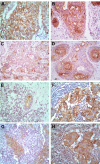Invasive breast cancer in Argentine women: association between risk and prognostic factors with antigens of a peptidic and carbohydrate nature
- PMID: 24367185
- PMCID: PMC3846659
- DOI: 10.2147/BCTT.S26833
Invasive breast cancer in Argentine women: association between risk and prognostic factors with antigens of a peptidic and carbohydrate nature
Abstract
Objective: In breast cancer, several tumor markers have been identified. The marker most extensively associated with breast cancer is MUC1. The objective of the study was to analyze prognostic and risk factors in relation to tumor markers in order to clarify breast cancer biology. A total of 349 primary tumor samples and lymph nodes from breast cancer patients were studied. Risk and prognostic factors were considered. An immunohistochemical approach was applied and an extensive statistical analysis was performed, including frequency analysis and analysis of variance. Correlation among variables was performed with principal component analysis.
Results: All the antigens showed an increased expression according to tumor size increment; moreover, sialyl Lewis x expression showed a significant increase in relation to disease stage, whereas Tn and TF presented a positive tendency. Vascular invasion was related to sialyl Lewis x expression and number of metastatic lymph nodes. Taking into account risk factors, when a patient had at least one child, Lewis antigens diminished their expression. In relation to breastfeeding, sialyl Lewis x expression diminished, although its apical expression increased.
Conclusion: Associations between MUC1 and carbohydrate antigens and risk and prognostic factors show the complexity of the cellular biological behavior that these antigens modulate in breast cancer.
Keywords: Argentine women; antigenic expression; breast cancer; prognostic factors; risk factors.
Figures






Similar articles
-
Expression of sialyl lewis X, sialyl Lewis A, E-cadherin and cathepsin-D in human breast cancer: immunohistochemical analysis in mammary carcinoma in situ, invasive carcinomas and their lymph node metastasis.Anticancer Res. 2005 May-Jun;25(3A):1615-22. Anticancer Res. 2005. PMID: 16033070
-
Comparative immunohistochemical study of MUC1 and carbohydrate antigens in breast benign disease and normal mammary gland.Appl Immunohistochem Mol Morphol. 2010 Jan;18(1):41-50. doi: 10.1097/PAI.0b013e3181ac1c20. Appl Immunohistochem Mol Morphol. 2010. PMID: 19625949
-
Immunohistochemical expression of sialyl Tn, sialyl Lewis a, sialyl Lewis a-b-, and sialyl Lewis x in primary tumor and metastatic lymph nodes in human gastric cancer.J Surg Oncol. 1996 Jul;62(3):171-6. doi: 10.1002/(SICI)1096-9098(199607)62:3<171::AID-JSO5>3.0.CO;2-4. J Surg Oncol. 1996. PMID: 8667623
-
Lewis x is highly expressed in normal tissues: a comparative immunohistochemical study and literature revision.Pathol Oncol Res. 2007;13(2):130-8. doi: 10.1007/BF02893488. Epub 2007 Jul 3. Pathol Oncol Res. 2007. PMID: 17607374 Review.
-
Overview of resistance to systemic therapy in patients with breast cancer.Adv Exp Med Biol. 2007;608:1-22. doi: 10.1007/978-0-387-74039-3_1. Adv Exp Med Biol. 2007. PMID: 17993229 Review.
References
-
- Ferlay J, Shin H-R, Bray F, Forman D, Mathers C, Parkin DM. Estimates of worldwide burden of cancer in 2008: GLOBOCAN 2008. Int J Cancer. 2010;127(12):2893–2917. - PubMed
-
- Ligtenberg MJ, Kruijshaar L, Bujis F, van Meijer M, Litvinov SV, Hilkens J. Cell-associated episalin is a complex containing two proteins derived from a common precursor. J Biol Chem. 1992;267(9):6171–6177. - PubMed
-
- Gendler S, Taylor-Papadimitriou J, Duhig T, Rothbar J, Burchell J. A highly immunogenic region of a human polymorphic epithelial mucin expressed by carcinomas is made up of tandem repeats. J Biol Chem. 1988;263(26):12820–12823. - PubMed
-
- Merlo G, Siddiqui J, Cropp C, et al. DF3 tumor-associated antigen gene is located in a region on chromosome 1q frequently altered in primary human breast cancer. Cancer Res. 1989;40(24):6966–6971. - PubMed
-
- McGuckin MA, Quinn RJ, Ward BG. Progesterone stimulates production and secretion of MUC1 epithelial mucin in steroid-responsive breast cancer cell lines. Int J Oncol. 1998;12:939–945. - PubMed
LinkOut - more resources
Full Text Sources
Research Materials
Miscellaneous

